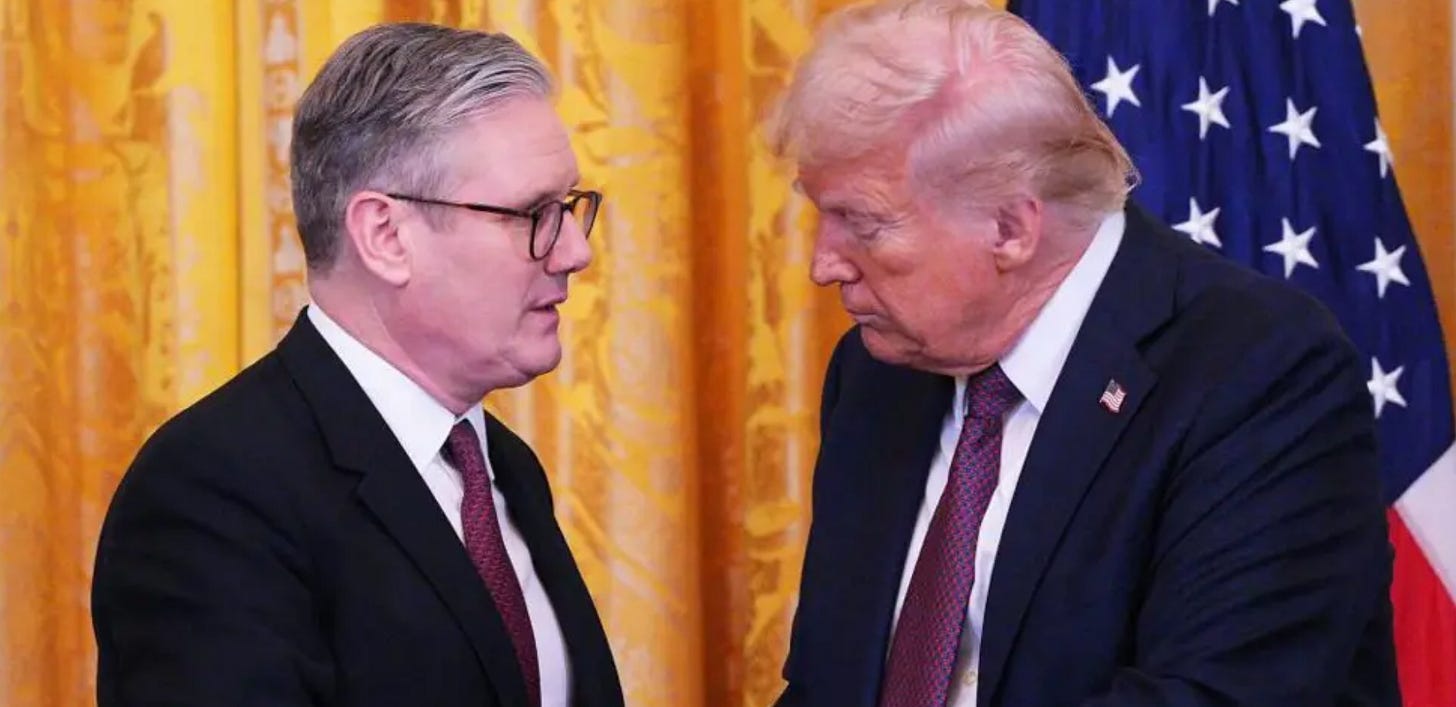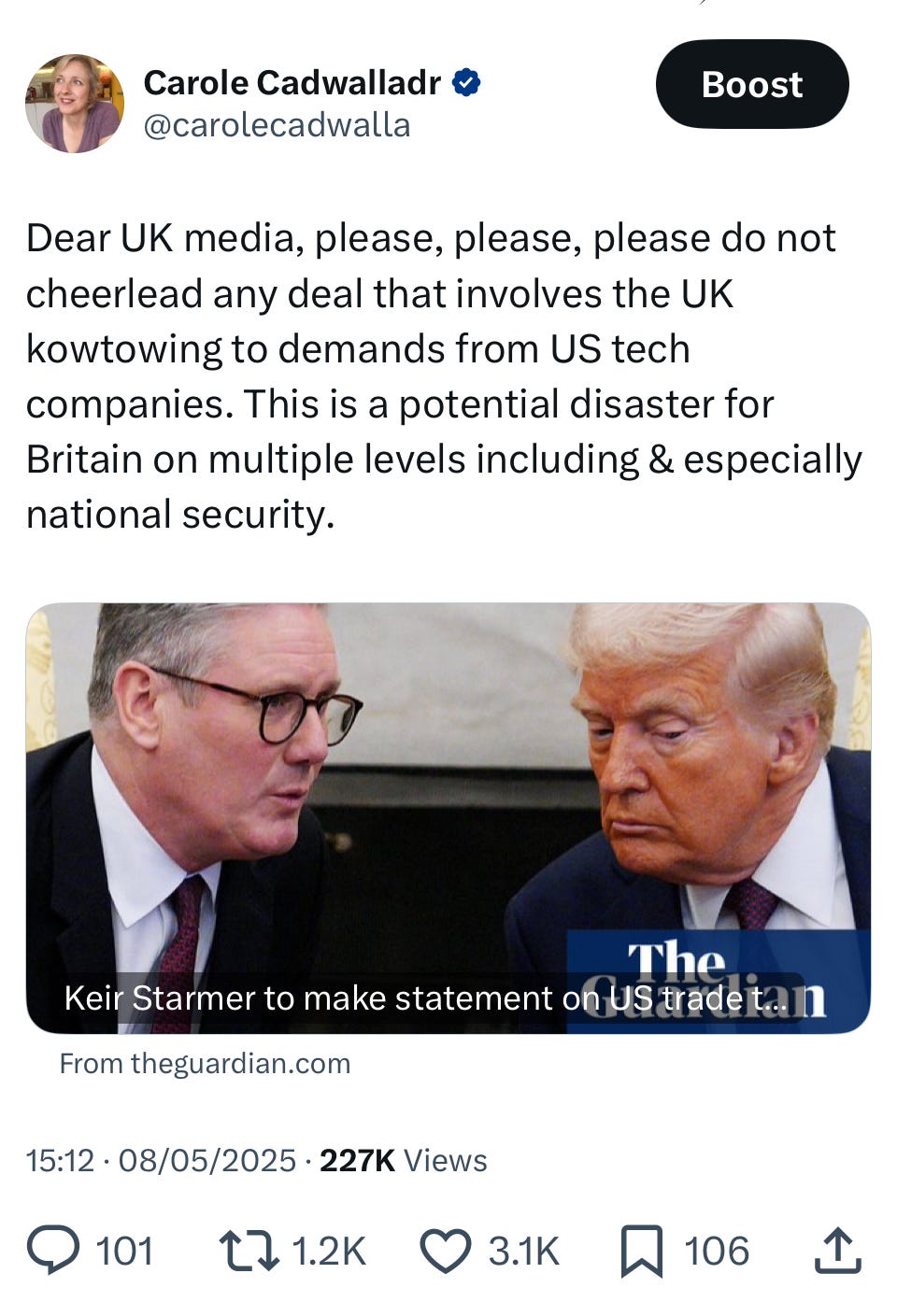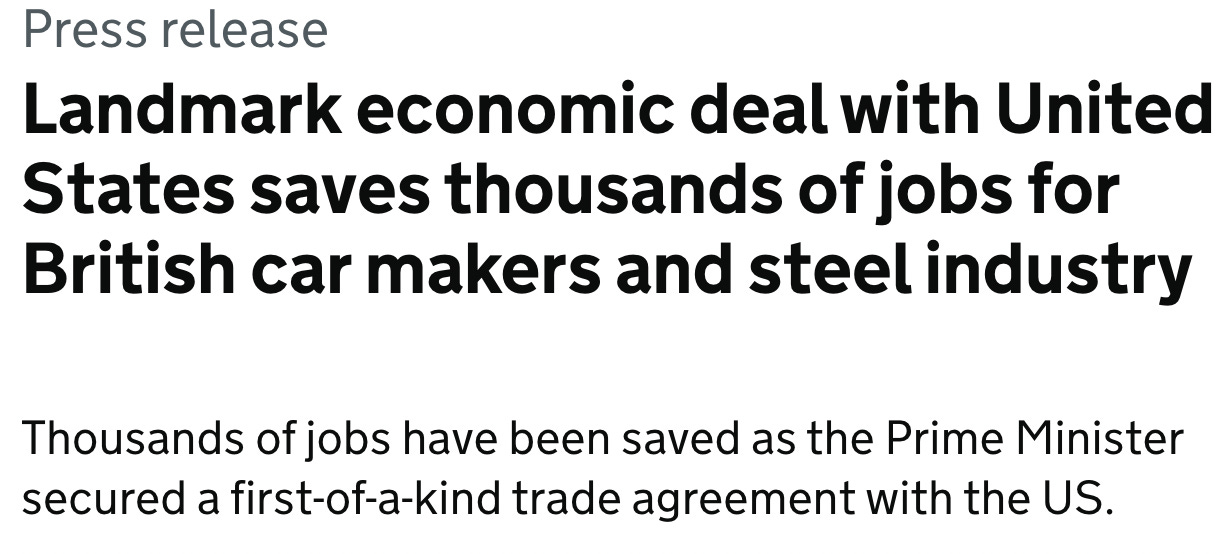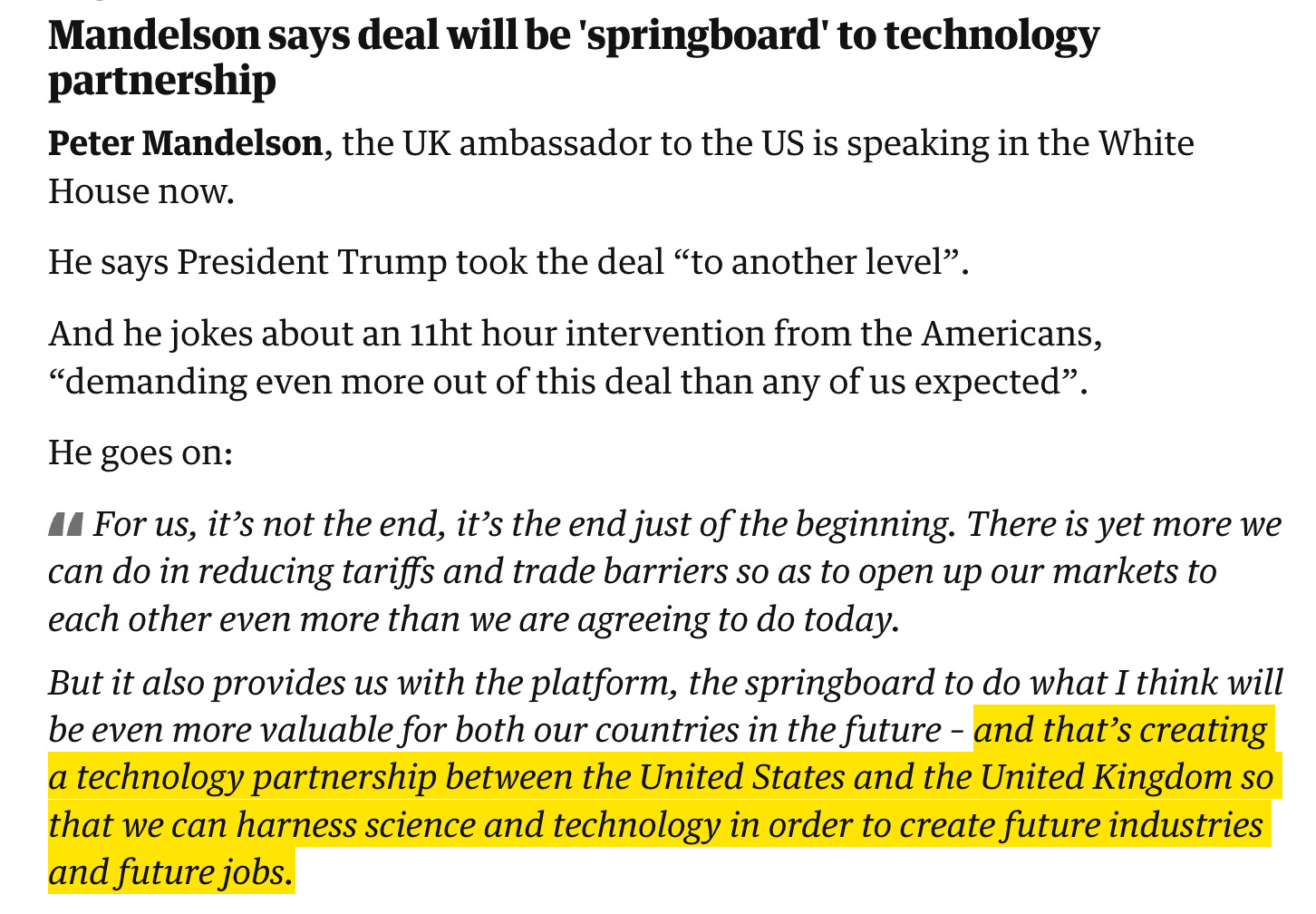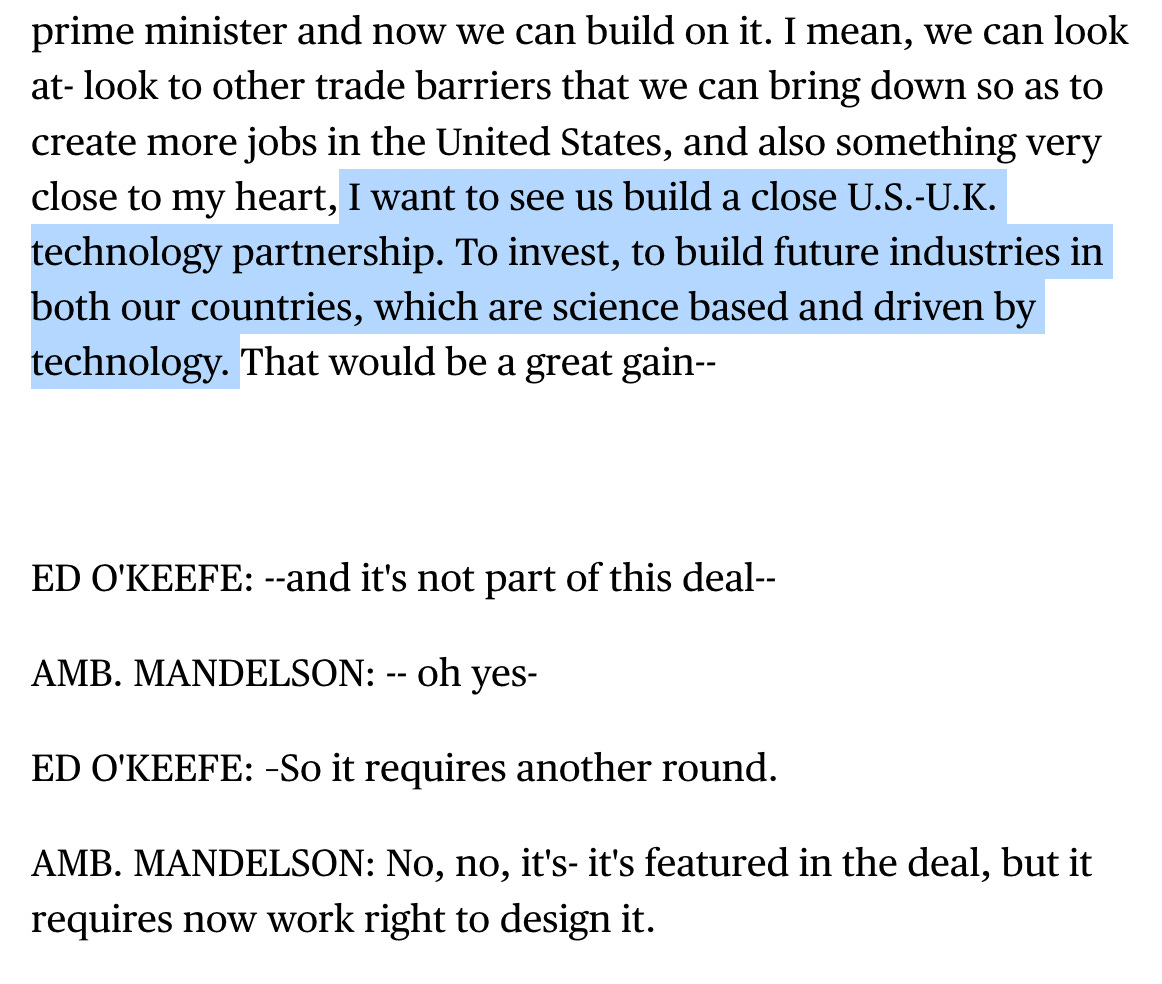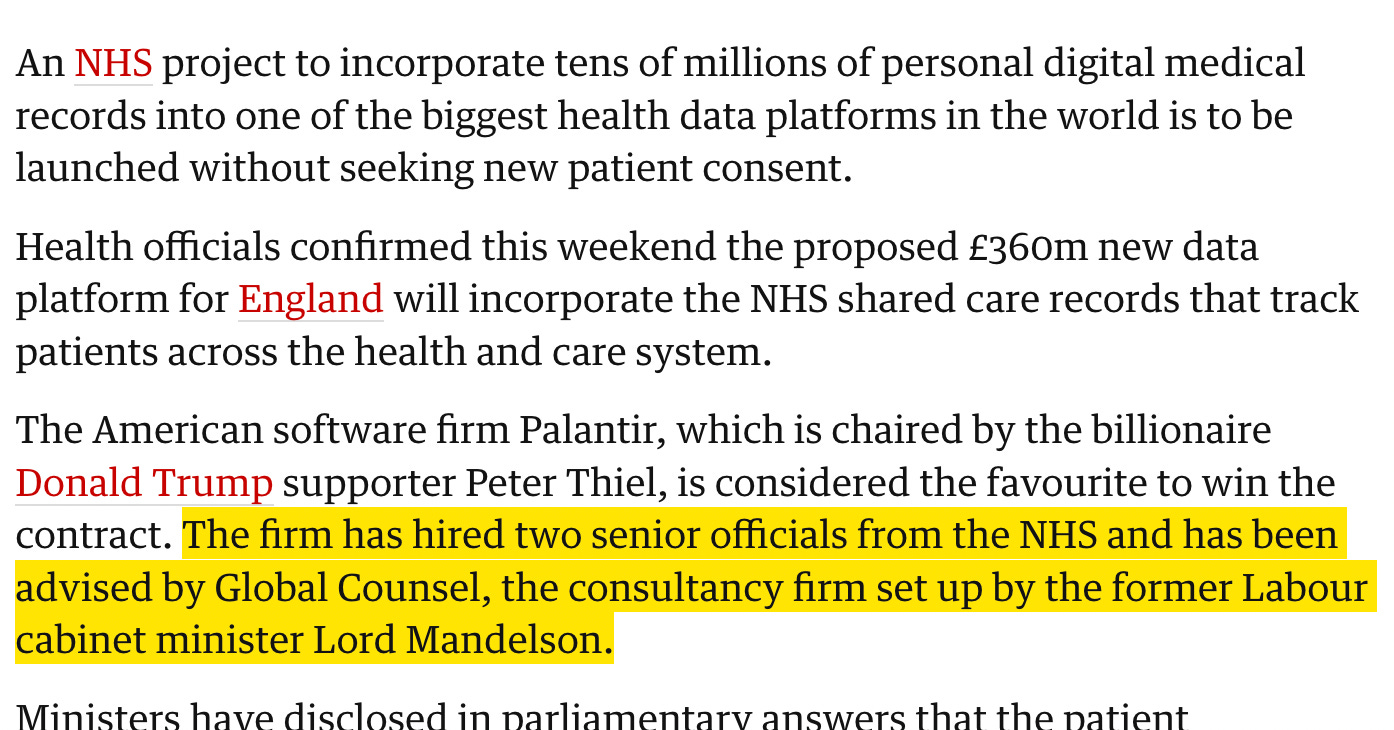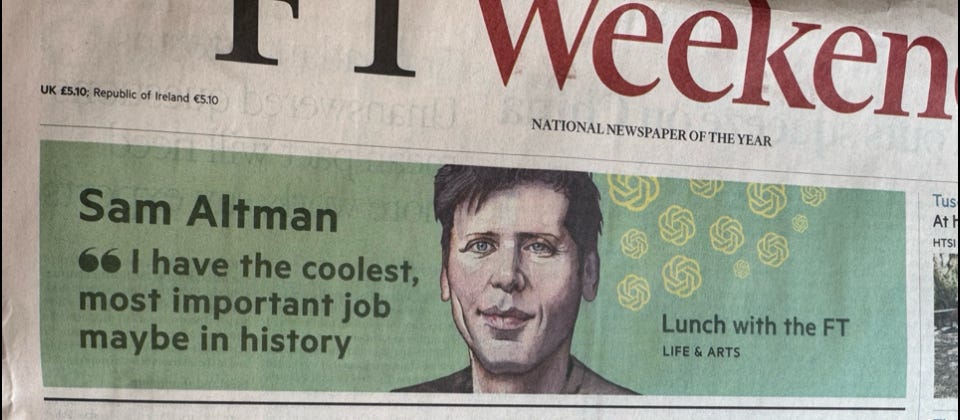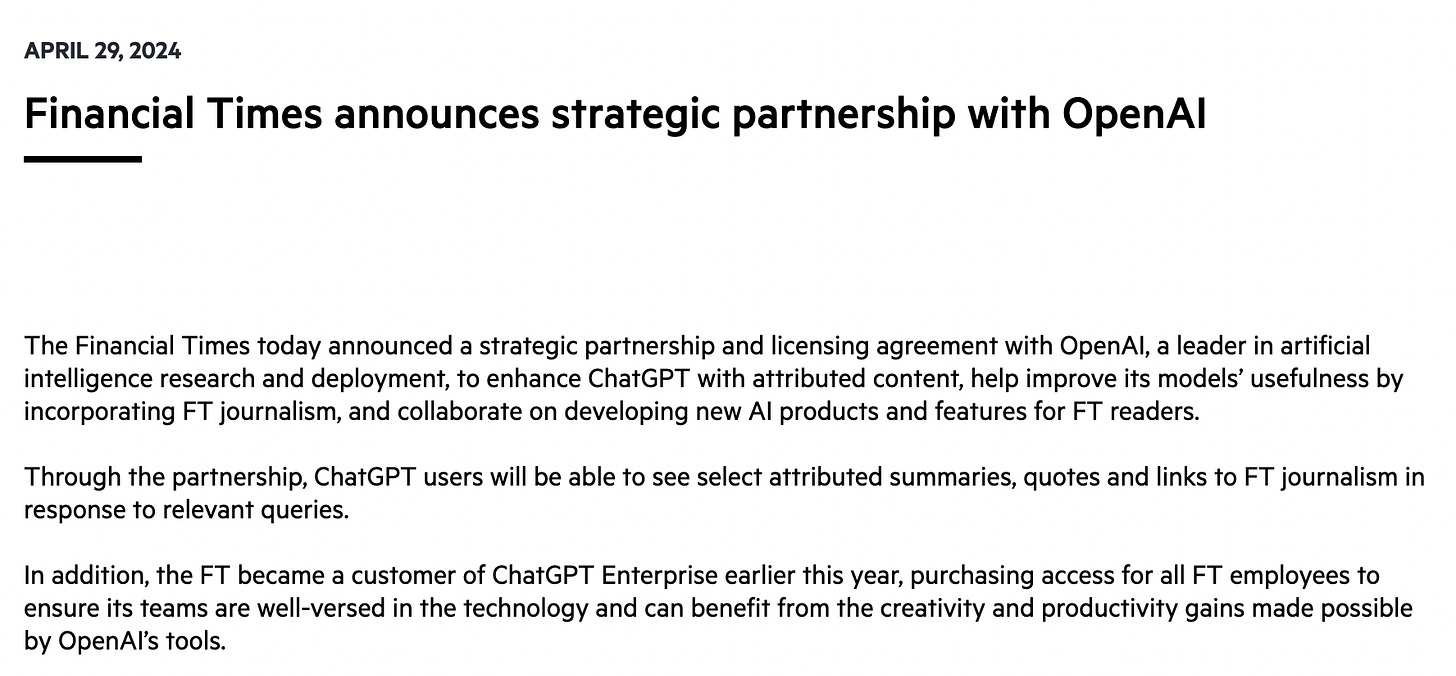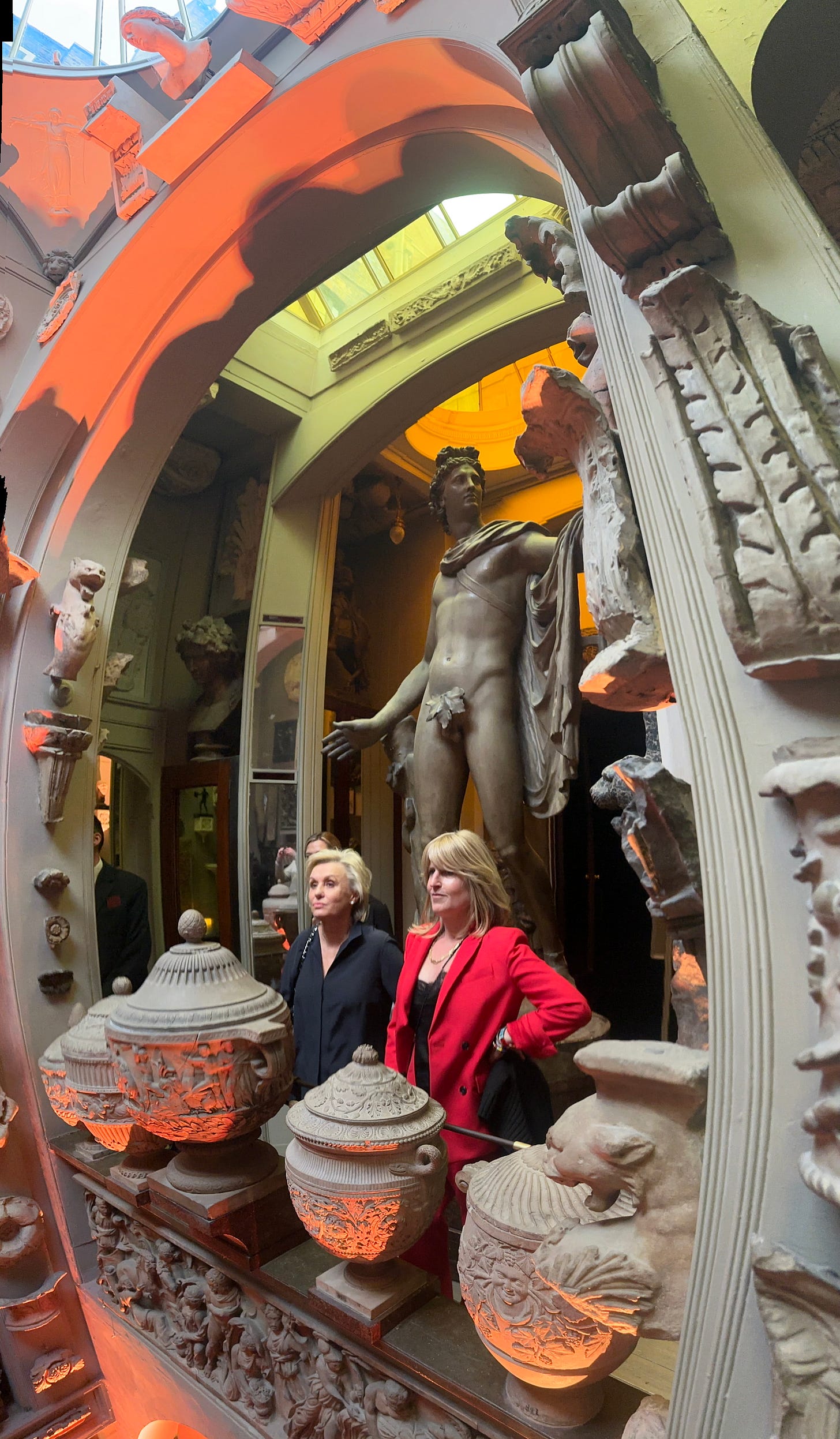A note on what I’m doing and why. I’m an investigative journalist who worked for the Guardian for 20 years latterly investigating the intersection of politics and technology that included 2018’s exposé of the Cambridge Analytica/Facebook scandal. The opaque and unaccountable Silicon Valley companies that facilitated both Brexit and Trump are now key players in an accelerating global axis of autocracy. I believe this is a new form and type of power: Broligarchy.
I’ve spent a lot of time this week thinking about journalism, talking about journalism, contemplating the future of journalism. Once upon a time, this might (rightly) have been considered naval gazing, a niche topic largely of interest to fellow journalists with more than a touch of self-important self interest about it.
But no more. The crisis in journalism is part of the crisis in information which underpins the crisis in democracy which are all a result of the revolution in communication brought about by new technology platforms. All of which is fuelling the far-right populist politics that are spreading across the world the world.
Now being supercharged by Trump. It’s not just that he’s launched an all-out assault on the press, though he has, last week’s executive order banning federal funding of US public service media through PBS and NPR is just one line of attack that includes suing multiple news organisations on spurious grounds. Or that Silicon Valley companies, pre-obeyed, axing fact checking, content moderation and trust and safety teams, undoing all the careful, diligent if inadequate work of the last decade, in order to show fealty to the new king of America. More than either of those, is his role as a chaos agent.
Trump has unleashed what feels like a tsunami of noise across the news cycle, a tumult in domestic US politics, in the world order. And to live through it feels like participating in mass cognitive collapse. It’s shortcircuited our brains. How can any of us keep up with, let alone process and understand what is happening?
That question was front of mind at Truth Tellers, a day-long conference in London, convened by Tina Brown, in homage to he late husband, the legendary editor, Harry Evans. He was the crusading journalist who exposed one of the great scandals of our times: Thalidomide, a drug given to pregnant women suffering from morning sickness that he revealed caused birth abnormalities.
It’s the third year of Truth Tellers and it’s the glammiest of any journalism conference I go to. Tina has an incredible black book – she got Woodward and Bernstein, the journalists who exposed Watergate, in the first year – and she always brings in the big beasts of the journalism and journalism-adjacent worlds, including this year, star speakers Yulia Navalny, the widow of the murdered Russian opposition leader, Alexei, and Jeffrey Goldberg, the editor of The Atlantic, famously added to Houthi PC small group Signal chat in which senior members of the Trump administration shared classified information on bombing Yemen.
“Every day is basically Watergate at the moment at this moment. Every day, there’s something extraordinary,” said Goldberg. And in terms of how to deal with Trump, he had one piece of advice: “The only way to act is to refuse to be bullied, refuse to be scared.”
The Atlantic, owned by a billionaire, Laurene Powell Jobs, the widow of Steve Jobs, is in a singular position. But it’s still a high-wire act. Jeffrey Goldberg said he had more lawyers in his office than journalists at one point, he said at another event.
But this year, there was one big change at the conference: Tina Brown, the queen of legacy journalism, the woman who turned around Vanity Fair and made it into the glossiest, splashiest must-read of the US magazine stand, who went on to edit the New Yorker and then set up the Daily Beast, is now…a Substacker.
She joined shortly before I did, in October, and it’s an interesting landmark for the site. Tina is a tastemaker and her interest in insurgent, new, independent journalism and having some of those voices included in the event was a welcome injection of energy. On a panel that included the executive editor of the New York Times and the editor-in-chief of Reuters, Anand Giridharadas, an ex-New York Times columnist, now Substacker summed up the problem:
“Our profession is doing some of the best work it’s ever done and in the eyes of the people we serve, we’re failing them…we are as trusted as much as political parties that people hate, as governments that people don’t trust any more. It’s an age of distrust.”
Trust in mastheads is declining, and in its stead, people are increasingly turning to individuals. This was repeated throughout the day. And while I’ve been a beneficiary of that, or at least Substack has been a lifeline in the post-Guardian bloodbath, it also very much not the final answer, not least because Substack is another VC-funded tech platform and I hope we’ve all learned by now that we can use them but not trust them.
I’m trying to host a conversation with Hamish McKenzie, the co-founder of Substack, and Tina Brown to discuss exactly this in the next couple of weeks. But I believe we need new networks, new forms of collaboration, new ground-up media organisations.
One person I bumped into at the summit was new Observer editor, James Harding. “How’s the Substack going? he asked me. “I’m chasing you,” I said. And I am. James Harding gave an interview last year, in which he said his news organisation, Tortoise, had now reached 100,000 subscribers with its newsletter. It took it five years, 70+ employees and £20m. I’m delighted to tell you that in five months, £0, no employees, How to Survive the Broligarchy now has 78,000 readers. We can do this.
A secret UK-US tech sweetheart deal?
I did try. I tweeted this before the details of the US-UK trade deal were released on Thursday.
It had zero effect. Much of the reporting in the UK followed the line of the government’s own press release:
The deal has been largely reported as some sort of rabbit-out-of-the-hat success in both the UK and the US.
With U.S. Trade Deal, British Steel Industry Feels Some Much Needed Relief, NY Times
Trump and Starmer confirm ‘breakthrough’ US-UK trade deal, the Guardian
Though there is no detail whatsoever on what else is in it. Instead, Starmer has largely been allowed to write his own headlines. But most importantly, I’ve not seen a single report that has picked up what appears to be a massive red flag: vaguely phrased comments from inside the Oval Office from Lord Mandelson, the UK government’s ambassador to the US who has been centrally involved in negotiating this deal. He said the deal would be a “springboard” for a US-UK “technology partnership”.
A what? springboard to what exactly? What does he mean by a “partnership”? We don’t know. This is information that neither the US nor UK government is revealing. Why on earth would the UK government want to get into any sort of relationship with Silicon Valley companies, right now? Most have shown themselves to be intrinsically aligned with and in hoc to an authoritarian president. Enmeshing ourselves in any deeper relationship than we already have is a profound threat to our national security and a future potential blackmail tool.
Later, Mandelson went on CBS and fleshed out a little bit more. This plan for a UK-US tie-up is “in the deal” but “requires work now to design it”.
Every bit of this is alarming. As is the fact that neither Mandelson nor Starmer or Trump is revealing what this is. There’s obviously much more here that is not yet being disclosed: why not?
And then there’s the Lord Mandelson of it. If you’re not familiar, Mandelson is a former minister in Tony Blair’s government, who has worked for decades as one of the most highly paid lobbyists in the Western hemisphere with clients who’ve ranged from Russian oligarchs to, you’ve guessed it, tech companies. Specifically, he has been a paid corporate lobbyist for Palantir, the secretive US data company and defence contactor, founded by Trump supporter and donor, Peter Thiel.
That’s the company that has more than $1bn in contracts with the US government, is currently working to create a massive real-time database and that according to the brilliant 404 Media (a non-corporate jounalistic collective, fyi) is front and centre of ICE’s efforts to track and locate alleged illegal immigrants and Venezuelan gang members and deport them.
To put this into the most black-and-white terms, Palantir is building:
“the technical infrastructure underpinning the Trump administration’s mass deportation efforts.”
Britain is already vulnerable. This company has already got its tentacles in the UK’s National Health Service via…you’ve guessed it,Lord Mandelson.
And, when Keir Starmer visited Washington to visit Donald Trump in February, he had just one other meeting: with, you’ve guessed it, Palantir. Arranged by, you’ve guessed it, Lord Mandelson.
The only commentator worth reading on the trade deal that I’ve seen this weekend is the Nobel Prize winner, Joseph Stiglitz. The deal, he says, is not worth the paper it’s written on.
“I would view it as playing into Trump’s strategy.
“His strategy is divide and conquer, go after the weakest countries, and sort of put the stronger countries in the back.”
But what Mandelson is signalling is even worse. He’s semaphoring a still-secret backroom deal between the UK and Silicon Valley that he is centrally involved in arranging.
In February, I wrote at length about the gross naivete of the UK government in its dealings with US tech companies, its over reliance on tech lobbyists, most notably Tony Blair, who has taken hundreds of millions of dollars from the founder of another shady US data company, Larry Ellison, who also has designs on our data.
And to top it all, the BBC’s Laura Kuenssberg featured the head of Palantir UK on its Sunday morning show. Louis Mosley. Why?
This is a company that is lobbying for UK government business. That is involved – as detailed above – in deportations that US courts have ruled are illegal. Why is this man on the BBC, not to be questioned, but as an appropriate political pundit by the BBC? [If you think he shouldn’t be, here’s the link to complain.]
There’s more. It turns out Kuenssberg actually has a scoop. Which she completely buries in a throwaway line when she asks Mosley her first question.
“You were actually there I understand at the Trump-Starmer first big talks in February. You were there in DC, in the White House, I think”
What? This is a new piece of information and also highly revealing. Why on earth was a senior executive from Palantir doing in the middle of the US-UK trade negotiation talks. And if you’re a BBC journalist and have found this out, why on earth aren’t you asking him why?
Fortunately, Joseph Stiglitz was also sitting in the studio.
“It undermined one of the basic longstanding principles of the rule of law in international trade. The most favoured nation principle. You give the same treatment to everybody…You are complicit in undermining international rule of law,” he said, the “you” here presumably being Britain. And then, he turned, specifically to Moseley to add, “and I wouldn’t be proud of that.”
ChatGPWhat?
My friend, Sam Altman, has been in the news again this weekend, seen here, on the front page of the FT Weekend.
“I have the coolest, most important job maybe in history,” he says modestly with no hubris whatsoever.
Lunch with the FT is a great institution. The interviews are often revealing, they get great names and the format gives it a familiar and reliable structure. In October, Press Gazette celebrated its anniversary and noted that “there are two rules for the Lunch: the guest chooses the restaurant and the FT pays the bill”. In this case, there was no restaurant and the FT didn’t pay: instead Sam Altman invited the FT editor, Roula Khalaf to his house in Napa Valley and cooked a pasta dish with vegetables grown on his land.
There’s only briefest of brief mention of politics, a fleeting namecheck of Tump, but the most surprising thing that’s missing is any mention of the fact that the FT is now in a “strategic partnership” with OpenAI.
It’s not mentioned in the piece or disclosed at the end of the article. This may be an oversight, as may have been the decision not to turn on comments for the article both on the site or on Instagram. I hope so. The whole issue of news organisations and their relationships and deals with AI firms is a hugely contentious area that has received not nearly enough attention.
Large, powerful, international news organisations like the FT and Guardian have enough leverage to strike lucrative deals while individuals and smaller organisations will never have that option. It’s the same argument, Joseph Stiglitz, used to criticise Trump’s trade deal: it might work for the strong, but it’s going to hammer and destroy the weak.
Meanwhile, the FT will be able to develop internal tools trained on FT journalists’ work. It’ll be up to those journalists to make their own judgement on where that might lead. It’s that word “partnership” again, that I’d personally be asking about.
Hanging out with smart people is fun
Thank you to the Citizens crew for organising an incredibly fun Substack Live with two of the smartest thinkers around on tech and culture, Kyle Chayka and Yancey Strickler.
Kyle writes brilliant things on technology for the New Yorker and wrote the excellent Filterworld about how social media algorithms are creating a type of cultural globalisation. And Yancey helped bringing into being hundreds of thousands of extraodinarily creative endeavours and projects to live though Kickstarter which he co-founded. He’s the man who literally invented crowdfunding.
I met Yancey at TED where he gave a fascinating talk (which hasn’t been posted yet) about a new concept he’s creating “A-Corps” or Artist Corporations, a new type of corporate structure that artists will be able to use to collaborate in more creative ways while protecting their rights. Basically…he’s reinventing capitalism. Really.
Honestly, I loved this conversation. It gave me a genuine buzz. It was also in places quite silly.
Last year Yancey published the Dark Forest Anthology of the Internet. This is how it begins:
“Five years ago back when this list was less than 500 people, I sent a post about how I felt increasingly reluctant to be myself online. The essay used the metaphor of the Dark Forest to explain a growing sense of danger that I and others felt.
“In response to the ads, the tracking, the trolling, the hype, and other predatory behaviors, we’re retreating to our dark forests of the internet, and away from the mainstream.
“Dark forests like newsletters and podcasts are growing areas of activity. As are other dark forests, like Slack channels, private Instagrams, invite-only message boards, text groups, Snapchat, WeChat, and on and on. These are all spaces where depressurized conversation is possible because of their non-indexed, non-optimized, and non-gamified environments.
“An increasing number of the population has scurried into their dark forests to avoid the fray.”
This conversation was a kind of dark forest. A safe space. Substack Lives have been the big new Substack innovation and on Friday morning, Kyle’s newsletter, One Thing, landed in my inbox taking the piss out of the new breed of one-man-band sole journalist operators, now talking heads yacking endlessly on live videos, and positioning themselves ourselves in opposition to traditional media outlets:
“We all used to be tiny Twitter avatars, but now there are talking heads on homepages and in sidebars, video clips silently chattering away until you click on them.”
It’s the performative nature of this that put me off. Or having to be “a multimedia character” as Kyle puts it. So, in some ways this is me out of my comfort zone, though I’ve decided to lean into this newsletter’s rough, hand-crafted, artisanal quality (it’s the typos that make you know it’s not written by AI, lol) by bringing the same game to my Substack Live: that shapeless lumberjack shirt and unbrushed hair? It’s how you know this is no corporate-funded news outlet.
For all Kyle’s self and other-directed barbs in his newsletter, he goes on to make what feels like an interesting insight here, that perhaps in an age of information chaos, conversation, trying to figure things out together, does help? Is that why we’re turning to podcasts and these kinds of live videos? To help us all feel less alone in the chaos?
The whole conversation is here and for more events like this, do sign up to the Citizens’ newsletter here.
The conversation certainly cheered me up, no end. I got Yancey to solve the problem of culture. And Kyle to solve the problem of media and journalism. Job done! It turned out they were genuinely optimistic about both. And by the end of it, I almost was too.
Full disclosure
I went to a fancy dinner courtesy of Substack. It was hosted at the amazing Sir John’s Soane’s Museum and featured an unlikely combo of rightwing podcast bros, Instagram influencers and legacy media refugees. Here’s a pic I captured that I’ve called 2 Blondes & A Penis: the magnificent Rachel Johnson and Tina Brown in the shadow of Apollo.
It was a clever choice of venue: Sir John Soane was an individual collector who started with nothing, the son of a bricklayer who built a quirky and endlessly idiosyncratic museum that isn’t the National Gallery and is all the better for it.
Thanks for listening!
This post has been syndicated from How to Survive the Broligarchy, where it was published under this address.

